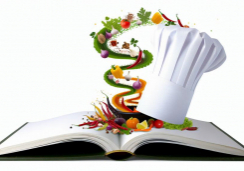10 Essentials for Crafting Healthy Vegan Recipes
Imagine you're in the kitchen, the scent of spices wafting through the air as you prepare a vegan feast that promises both nourishment and flavor. You know that a well-stocked pantry and a keen understanding of nutritional balance are just the beginning.
As you assemble your ingredients, you realize that creating satisfying vegan meals is an art that relies on a foundation of diverse proteins, whole grains, essential fats, and a rainbow of vegetables. Yet, there's more to it than just throwing together plant-based foods; it's about understanding how to combine them to achieve a synergy of taste and health benefits.
You're on the cusp of discovering the secrets to elevating your vegan cooking, but where do you start, and how do you ensure that your dishes delight the palate as much as they nourish the body?
Join us as we explore the essential elements that will transform your vegan meals from simple to sublime.
Balanced Nutritional Content
To maintain optimal health on a vegan diet, it's crucial to include a balance of protein, healthy fats, and a variety of fruits and vegetables in your recipes.
Vegan protein is a cornerstone of such a diet, and sourcing it requires careful selection. Incorporate legumes, including green lentils which aren't only rich in protein but also fiber and essential minerals. Tofu, tempeh, and seitan also offer high-quality protein that can be easily integrated into your meals.
Don't overlook the power of seeds—chia seeds and hemp seeds aren't only excellent sources of protein but also provide omega-3 fatty acids and various vital nutrients. These seeds can be sprinkled on salads, blended into smoothies, or used to create nutrient-dense puddings.
A colorful array of fruits and vegetables will supply you with a spectrum of vitamins, minerals, and antioxidants necessary for combating oxidative stress and supporting immune function. Meanwhile, healthy fats from avocados, nuts, and olive oil contribute to satiety and are essential for absorbing fat-soluble vitamins.
Lastly, whole grains and plant-based dairy alternatives add diversity to your diet, ensuring you're getting a well-rounded array of macronutrients and micronutrients. Balance is key, and by choosing a variety of these components, your vegan recipes won't only be delicious but also nutritionally complete.
Diverse Protein Sources
Diversifying your protein intake is essential when crafting a healthy vegan diet, and there's a wealth of plant-based options that can help you achieve this. Protein is a vital nutrient for maintaining muscle mass, supporting metabolism, and ensuring that your body functions optimally. As someone on a vegan diet, it's important to include a variety of protein sources to ensure you're getting all essential amino acids.
Here are some protein-rich foods to incorporate into your diet:
- Legumes: Swap out meat with legumes like lentils, chickpeas, and especially black beans, which aren't only protein-dense but also rich in fiber and iron.
- Nuts and Seeds: Add a satisfying crunch and nutrient boost to your meals with almonds, walnuts, and pine nuts, perfect for salads and as a topping on dishes.
- Soy Products: Tofu, tempeh, and edamame are versatile meat substitutes that absorb flavors well, such as soy sauce, making them a staple in vegan cooking.
- Seitan: Made from wheat gluten, seitan has a meat-like texture and is a great source of protein, ideal for those looking to replicate traditional meat dishes.
Including these diverse sources ensures you're not reliant on a single type of protein, such as canned beans, and it keeps your meals interesting and nutritionally balanced.
Whole Grain Selections
Incorporating whole grains like quinoa, brown rice, and whole wheat pasta into your vegan diet enriches your meals with essential nutrients and dietary fiber. These whole foods aren't just about elevating the health quotient; they also bring texture and heartiness to your table. You'll be crafting dishes that are as satisfying as they're nutritious.
Experimenting with different whole grain selections allows you to discover which ones serve as the best base for your meals. Whether it's the nutty flavor of quinoa, the chewy substance of brown rice, or the robustness of whole wheat pasta, there's a grain to complement every dish. Try them in quinoa salads, brown rice stir-fries, or whole wheat pasta dishes, and watch how they transform your cooking.
Opting for whole grain over refined grains significantly enhances the nutritional value of your vegan recipes. They're a versatile and filling ingredient that provides a wholesome foundation for plant-based meals. By making whole grain selections, you're not just satisfying your hunger; you're also contributing to your overall health and well-being. Make sure your pantry is stocked with these power-packed staples for a well-rounded vegan diet.
Essential Fatty Acids
You've learned about the importance of whole grains in your vegan diet, but let's not overlook the critical role of Essential Fatty Acids (EFAs).
Ensuring you include omega-3 rich plant sources like flaxseeds and walnuts can greatly benefit your heart and brain health.
It's also vital to balance your intake of Omega-3 and Omega-6 fatty acids to support your body's inflammation regulation and overall well-being.
Omega-3 Plant Sources
To maintain a well-rounded vegan diet, it's crucial to include plant sources of omega-3 fatty acids, such as flaxseeds, chia seeds, and algae oil, which play a vital role in heart and brain health. These sources are rich in essential fats that your body can't produce on its own.
Here are ways to integrate these omega-3 powerhouses into your meals:
- Flaxseeds: Grind them into a meal and add to smoothies or oatmeal.
- Chia Seeds: Mix into overnight oats or create a pudding for a fiber-rich treat.
- Algae Oil: A convenient supplement, ideal for dressings or added to soups.
- Whole Foods: Combine with whole grains and black beans in salads for a balanced nutrient profile.
Balancing Omegas Ratio
Understanding the delicate balance between omega-3 and omega-6 fatty acids is key to optimizing heart and brain health in your vegan diet. While you're whipping up a storm with black beans, sweet potato, and vegan cheese, remember these aren't just tasty ingredients—they're also part of the puzzle in getting your omegas right.
Flaxseeds and chia seeds, tossed into a salad or blended into a coconut milk smoothie, can boost your omega-3 intake. Balance that with omega-6-rich foods like sunflower seeds.
Including a variety of whole food fats ensures you aren't just eating well—you're also supporting your well-being. So, be mindful of your fats; it's not just about quantity but also the quality and ratio that matter.
Fatty Acids Benefits
While balancing your intake of omega fatty acids, it's worth noting how these essential nutrients benefit your overall health, particularly in brain function and reducing inflammation.
To ensure you're getting the most from your vegan diet, follow dietary guidelines that emphasize the inclusion of plant-based meals rich in fatty acids.
These benefits are crucial and include:
- Enhanced cognitive function and neurological development
- Significant anti-inflammatory effects to support joint and heart health
- Necessary nourishment for radiant skin and strong hair
- Effective absorption of vital fat-soluble vitamins
Fresh Vegetable Variety
As you explore healthy vegan recipes, incorporating a variety of seasonal produce can enhance both the nutritional value and taste of your meals.
Opting for a colorful plate not only creates a visually appealing dish but also ensures you're getting a diverse array of essential nutrients.
Different cooking methods can bring out unique flavors and textures in vegetables, adding excitement to your vegan culinary adventures.
Seasonal Produce Selection
Harnessing the bounty of each season, you'll find that incorporating fresh, seasonal vegetables into your vegan recipes not only enhances flavor but also assures peak nutritional value. Your favorite vegan dishes can be elevated with easy vegan meals that use simple swaps based on seasonal produce selection. Here's how you can make the most out of each season:
- Spring: Asparagus and artichokes add a tender crispness to light pasta dishes.
- Summer: Ripe tomatoes and bell peppers bring a burst of freshness to salads and salsas.
- Fall: Squash and sweet potatoes lend a comforting sweetness to soups and stews.
- Winter: Kale and cabbage offer a robust texture for warm, hearty meals.
Colorful Plate Benefits
Diversifying your plate with a rainbow of vegetables not only makes for a visually appealing meal but also ensures a rich intake of various essential nutrients. Each hue represents a different set of vitamins, minerals, and antioxidants that contribute to overall health. For instance, dark leafy greens are packed with iron and calcium, while bright reds and oranges provide vitamin C and beta-carotene.
Incorporating a wide array of vegan products and fresh produce into your easy meals requires some planning. Meal prep is key; it allows you to design a week's worth of dishes that are both nutrient-dense and varied. Stocking your pantry with diverse pantry items encourages culinary creativity and can also help you save money on groceries.
Flavorful Herb Use
Incorporating herbs like basil, cilantro, parsley, thyme, and rosemary into your vegan recipes can significantly enhance both the taste and nutritional value of your meals. These natural flavor powerhouses add depth and freshness that can turn even the simplest dishes into a burst of culinary delight. Whether you're aiming for a creamy texture in a sauce or a vibrant garnish, herbs are your go-to solution.
Here's how to maximize their potential in your cooking:
- Experiment with Combinations: Pairing herbs can create complex flavors; think cilantro and lime for a zesty twist, or basil and tomato for a classic pairing.
- Fresh Finish: Toss fresh herbs over your finished dish for an instant upgrade in aroma and visual appeal.
- Dried for Convenience: Keep dried herbs on hand for those busy days when ease is essential. They're perfect for slow-cooked meals where their flavor has time to develop.
- Grow Your Own: If space allows, cultivate an herb garden for the freshest taste and an ongoing supply.
Spice Combination Artistry
Mastering the art of spice combinations can elevate your vegan dishes from mundane to mouthwatering with just a pinch or a sprinkle. When you're crafting a vegan chili with black beans, for example, the right blend of cumin, chili powder, and smoked paprika can transform the legumes into a robust and savory experience.
As you refine your spice combination artistry, consider the flavor profiles you want to achieve. Do you seek warmth, sweetness, or a kick of heat? Spices like cinnamon add a subtle sweetness, perfect for dishes like Moroccan tagines, while cayenne pepper provides a punch that can liven up a simple hummus whipped up in your food processor.
When compiling your shopping list, think beyond salt and pepper. Research has shown that a diverse spice intake can't only enhance flavor but also contribute to your overall health. Turmeric, for instance, is lauded for its anti-inflammatory properties.
Cooking Technique Mastery
Understanding the various cooking techniques such as sautéing, roasting, and grilling is crucial for bringing out the best in your vegan ingredients and elevating the overall taste and texture of your dishes. Cooking technique mastery isn't just about following a step-by-step guide; it's about making each ingredient shine.
Consider black beans — a staple in vegan cuisine. The right technique can transform them from simple legumes to a savory, satisfying component of your meal.
Here's why honing your cooking skills matters:
- Sautéing: Quickly cooking vegetables in a bit of oil over medium-high heat enhances their natural flavors without losing nutrients.
- Roasting: This method intensifies the sweetness and richness of vegetables and legumes, giving a delightful depth to dishes.
- Steaming: Preserves the color, texture, and nutritional value of ingredients like broccoli and spinach, making them more appealing and healthier.
- Food Processor: Utilizing this tool can create smooth hummus, puree soups, or even make veggie burgers, showing the versatility of vegan ingredients.
Balancing flavors, controlling temperature, and experimenting with cooking times are all part of the journey. As you become more adept at these techniques, you'll find that crafting delicious vegan meals becomes second nature.
How Can I Use Seasonal Ingredients in Crafting Healthy Vegan Recipes?
When creating healthy vegan recipes, incorporating seasonal ingredient recipe essentials can take your dishes to the next level. Utilize fresh fruits, vegetables, and herbs that are in season to add vibrant flavors and nutrients to your meals. Experiment with local produce to create delicious and sustainable plant-based dishes.
Creative Meat Alternatives
As you delve into the world of vegan cooking, discovering a plethora of plant-based protein sources like lentils, chickpeas, tofu, tempeh, and seitan can revolutionize your approach to crafting satisfying meat-free alternatives. Black beans, for instance, aren't only rich in protein but also fiber, and they can form the foundation of a hearty veggie burger. Pulverizing them in a food processor ensures a consistent texture that mimics ground meat.
To bind these ingredients together, consider using flax eggs or mashed potatoes, which promote the structural integrity of your creations without compromising on health. For a robust flavor that elevates your dish, sautéing a mirepoix or a blend of garlic and herbs can add depth. Don't hesitate to stir in a smoky BBQ sauce for that classic savory tang, or crumble in some vegan feta cheese for a Mediterranean twist.
Lastly, achieving that desired contrast of a tender interior and crispy exterior in your meat alternatives is possible by incorporating breadcrumbs or whole wheat flour. This balance is crucial, as it contributes to the overall satisfaction of enjoying a well-crafted vegan dish that stands as a worthy counterpart to traditional meat-based meals.
Seasonal Ingredient Incorporation
Why not elevate your vegan culinary creations by incorporating seasonal ingredients that promise peak flavor and optimal nutrition? Seasonal produce not only tastes better but is often more nutrient-dense, having been harvested at its prime. By choosing ingredients that are naturally at their best, you're ensuring that your dishes are both delicious and nourishing.
Consider these benefits of using seasonal ingredients:
- Enhanced Flavor: Fruits and vegetables picked during their peak season have the optimal flavor profile, making them a delight in any dish.
- Nutritional Superiority: Seasonal produce is often richer in vitamins and minerals, as it hasn't been stored for long periods.
- Environmental Stewardship: Choosing local, seasonal produce reduces the carbon footprint associated with long-distance transportation.
- Economic Savvy: Seasonal ingredients can be more affordable when they're abundant and don't require long-distance shipping.
For example, imagine making a creamy Alfredo sauce without any animal products. You can use a food processor to blend seasonal cashews with nutritional yeast and spices for a rich, comforting sauce. Or, to add protein and texture to your meals, why not toss in some black beans? They're versatile, nutritious, and pair well with an array of seasonal vegetables.
Conclusion
As you embrace your vegan culinary journey, remember to balance nutrition with diverse proteins, whole grains, and essential fats.
Don't skimp on vegetable variety or spice artistry; they're crucial for vibrant dishes.
Master cooking techniques and get creative with meat alternatives to keep meals exciting.
Always incorporate seasonal ingredients for freshness and sustainability.
With these essentials, you'll craft healthy, delicious vegan recipes that satisfy taste buds and support well-being.
Happy cooking!










